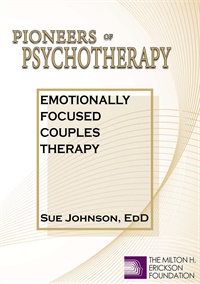
- Average Rating:
- Not yet rated
- Topic Areas:
- Clinical Demonstrations | Couples Therapy | Emotionally Focused Therapy (EFT) | Psychotherapy
- Bundle(s):
- Women Pioneers of Psychotherapy | Pioneers of Psychotherapy Bundle
- Categories:
- Pioneers of Psychotherapy | Evolution of Psychotherapy | Evolution of Psychotherapy 2009
- Faculty:
- Sue Johnson, EdD
- Course Levels:
- Master Degree or Higher in Health-Related Field
- Duration:
- 00:52:00
- Format:
- Audio and Video
- Original Program Date:
- Dec 11, 2009
- Short Description:
- Patsy and Josh are a volunteer couple, already in Emotionally Focused Therapy. They are further helped through an EFT session with Sue Johnson. Patsy, suffering from deep wounds of the past, is vulnerable and fearful, and often shuts down—even though she knows her actions prevent connection with Josh. Her husband tries to be caretaker and nurturer. Johnson helps them stay with emotion, expand their connection and shapes their interaction bringing both to a safer, more loving place.
- Price:
- $59.00 - Base Price

- Average Rating:
- Not yet rated
- Topic Areas:
- Clinical Demonstrations | Couples Therapy | Strategic Therapy
- Bundle(s):
- Women Pioneers of Psychotherapy | Pioneers of Psychotherapy Bundle
- Categories:
- Pioneers of Psychotherapy | Evolution of Psychotherapy | Evolution of Psychotherapy 2009 | Pioneers in Couples and Family Therapy
- Faculty:
- Cloe Madanes, HDL, LIC
- Course Levels:
- Master Degree or Higher in Health-Related Field
- Duration:
- 00:57:00
- Format:
- Audio and Video
- Original Program Date:
- Dec 10, 2009
- Short Description:
- This clinical demonstration features a couple navigating conflict around holiday celebrations rooted in past trauma and unmet emotional needs. Through guided dialogue, core needs like significance, honesty, growth, and connection are identified. Strategies include emotional expression, increased affection, and a closing exercise designed to strengthen intimacy and deepen their bond.
- Price:
- $59.00 - Base Price
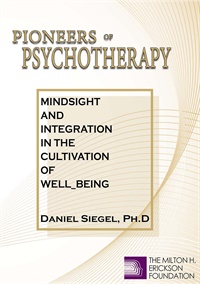
- Average Rating:
- Not yet rated
- Topic Areas:
- Clinical Demonstrations | Psychotherapy | Relationships | Mindfulness | Neurobiology
- Bundle(s):
- Pioneers of Psychotherapy Bundle
- Categories:
- Pioneers of Psychotherapy | Evolution of Psychotherapy | Evolution of Psychotherapy 2009
- Faculty:
- Daniel Siegel, MD
- Course Levels:
- Master Degree or Higher in Health-Related Field
- Duration:
- 00:56:00
- Format:
- Audio and Video
- Original Program Date:
- Dec 10, 2009
- Short Description:
- Daniel Siegel (2009) Mindsight and Integration in the Cultivation of Well-Being demonstrates interpersonal neurobiology therapy with a volunteer studying to be a therapist. She has experienced fear in one clinical setting and has also been “the glue,” holding together her family since she was young. Siegel uses the triangle of relationship/ mind/brain to help the volunteer experience her fear of responsibility by allowing images and body sensations to flow to “soften the mind.”
- Price:
- $59.00 - Base Price

- Average Rating:
- Not yet rated
- Topic Areas:
- Clinical Demonstrations | Meditation, Spirituality and Yoga | Psychotherapy | Interviewing
- Bundle(s):
- Pioneers of Psychotherapy Bundle
- Categories:
- Pioneers of Psychotherapy | Evolution of Psychotherapy | Evolution of Psychotherapy 2009
- Faculty:
- James Hillman, PhD
- Course Levels:
- Master Degree or Higher in Health-Related Field
- Duration:
- 00:53:00
- Format:
- Audio and Video
- Original Program Date:
- Dec 10, 2009
- Short Description:
- James Hillman (2009) Hillman reveals how to bring “soul talk” back into modern psychotherapy. The case history of a client is the diagnosis, present complaint, family history, employment history, but nothing of the “soul” of the person. Dr. Hillman assures us that we can almost ignore the case history. Using “soul” talk (Longings, dreams, secrets, how a client accepts joy and sorrow) takes the session out of the box and returns a resonance to psychotherapy that it has lost.
- Price:
- $59.00 - Base Price
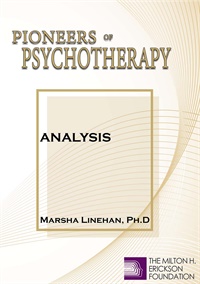
- Average Rating:
- Not yet rated
- Topic Areas:
- Clinical Demonstrations | Psychotherapy | Chain Analysis | Therapist Development
- Bundle(s):
- Women Pioneers of Psychotherapy | Pioneers of Psychotherapy Bundle
- Categories:
- Pioneers of Psychotherapy | Evolution of Psychotherapy | Evolution of Psychotherapy 2009
- Faculty:
- Marsha Linehan, PhD
- Course Levels:
- Master Degree or Higher in Health-Related Field
- Duration:
- 00:57:00
- Format:
- Audio and Video
- Original Program Date:
- Dec 10, 2009
- Short Description:
- Marsha Linehan (2009) provides dynamic, engaging demonstrations with two separate volunteers using nonjudgmental “chain analysis” to identify their problem behavior and look for controlling variables. Rather than using self-discipline, she suggests practical methods such as listing pros and cons and setting up consequences if the behavior continues. Both volunteers reported great satisfaction with the process.
- Price:
-
Nate Sub 1.1 Price is $0.00
price reduced from Base Price - $59.00
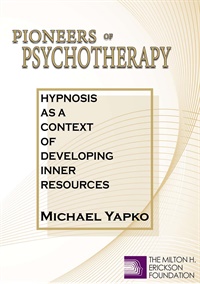
- Average Rating:
- Not yet rated
- Topic Areas:
- Clinical Demonstrations | Hypnosis | Resources
- Bundle(s):
- Pioneers of Psychotherapy Bundle
- Categories:
- Pioneers of Psychotherapy | Evolution of Psychotherapy | Evolution of Psychotherapy 2009
- Faculty:
- Michael Yapko, PhD
- Course Levels:
- Master Degree or Higher in Health-Related Field
- Duration:
- 00:58:00
- Format:
- Audio and Video
- Original Program Date:
- Dec 10, 2009
- Short Description:
- Michael Yapko (2009) works with a volunteer, a medical student, who feels “frozen” to advance professionally. Fearing public speaking and feeling blocked in writing she wants to feel centered and motivated. Yapko uses hypnosis –what he calls, “the original positive psychology”— to free her from feeling stuck and to help her take risks to move forward.
- Price:
- $59.00 - Base Price
Tags: Hypnosis Resources Michael Yapko
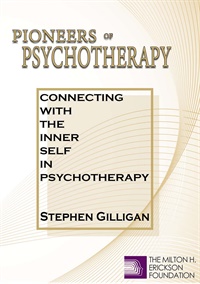
- Average Rating:
- Not yet rated
- Topic Areas:
- Clinical Demonstrations | Psychotherapy | Hypnosis | Hypnotic Induction | Community | Meditation, Spirituality and Yoga
- Bundle(s):
- Pioneers of Psychotherapy Bundle
- Categories:
- Pioneers of Psychotherapy | Brief Therapy Conference | Brief Therapy Conference 2008
- Faculty:
- Stephen Gilligan, PhD
- Course Levels:
- Master Degree or Higher in Health-Related Field
- Duration:
- 00:53:00
- Format:
- Audio and Video
- Original Program Date:
- Dec 12, 2008
- Short Description:
- Stephen Gilligan (2008) demonstrates the induction of a trance with a volunteer who wants to “feel at home” with herself, but often feels disconnected and scattered. He invites intention and uses mindfulness and body movement to release the weight of fear and disconnection. Afterward, the volunteer claims the experience was “intense,” and “beautiful.”
- Price:
- $59.00 - Base Price
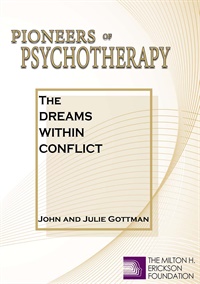
- Average Rating:
- Not yet rated
- Topic Areas:
- Clinical Demonstrations | Dreamwork | Gottman Method | Psychotherapy
- Bundle(s):
- Pioneers of Psychotherapy Bundle
- Categories:
- Pioneers of Psychotherapy | Evolution of Psychotherapy | Evolution of Psychotherapy 2005
- Faculty:
- John Gottman, PhD | Julie Gottman, PhD
- Course Levels:
- Master Degree or Higher in Health-Related Field
- Duration:
- 00:59:00
- Format:
- Audio and Video
- Original Program Date:
- Dec 09, 2005
- Short Description:
- John Gottman and Julie Gottman (2005) demonstrate through role-playing the ways therapists can break a couples’ gridlock due to conflict. Through an intervention of “dreams within the conflict,” therapists are shown how to help couples be more open for dialogue in order to successfully compromise on unresolvable issues.
- Price:
- $59.00 - Base Price
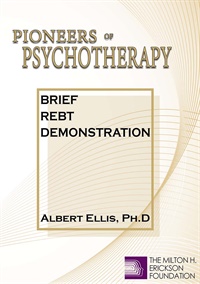
- Average Rating:
- Not yet rated
- Topic Areas:
- Clinical Demonstrations | Rational Emotive Behavior Therapy (REBT) | Anger | Humor | Psychotherapy
- Bundle(s):
- Pioneers of Psychotherapy Bundle
- Categories:
- Pioneers of Psychotherapy | Evolution of Psychotherapy | Evolution of Psychotherapy 2000
- Faculty:
- Albert Ellis, PhD
- Course Levels:
- Master Degree or Higher in Health-Related Field
- Duration:
- 00:51:00
- Format:
- Audio and Video
- Original Program Date:
- May 27, 2000
- Short Description:
- Albert Ellis (2000) demonstrates with two volunteers. The first volunteer is angry and intimidated by her supervisors. Humor and imagery are incorporated. The second volunteer feels a need to control others and is angry when she can’t. Ellis uses imagery to correct cognitive patterns and produce an emotional shift.
- Price:
- $59.00 - Base Price
Tags: REBT Humor Anger Psychotherapy Albert Ellis

- Average Rating:
- Not yet rated
- Topic Areas:
- Clinical Demonstrations | Bioenergetics | Eating Disorders | Aging and Mortality | Psychotherapy | Abuse | Mind-Body
- Bundle(s):
- Pioneers of Psychotherapy Bundle
- Categories:
- Pioneers of Psychotherapy | Evolution of Psychotherapy | Evolution of Psychotherapy 2000
- Faculty:
- Alexander Lowen, MD
- Course Levels:
- Master Degree or Higher in Health-Related Field
- Duration:
- 00:59:00
- Format:
- Audio and Video
- Original Program Date:
- May 27, 2000
- Short Description:
- Alexander Lowen (2000) demonstrates with Ann, who he used as a ten years earlier. She reports that since that first session she has been free of severe asthma attacks. She is now troubled by the death of her father and mother, abuse from her brother, excessive weight gain and the onset of menopause. Lowen guides her through a series of movement exercises.
- Price:
- $59.00 - Base Price
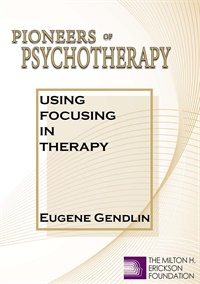
- Average Rating:
- Not yet rated
- Topic Areas:
- Clinical Demonstrations | Trauma | Psychotherapy | Focusing | Mind-Body
- Bundle(s):
- Pioneers of Psychotherapy Bundle
- Categories:
- Pioneers of Psychotherapy | Evolution of Psychotherapy | Evolution of Psychotherapy 2000
- Faculty:
- Eugene Gendlin, PhD
- Course Levels:
- Master Degree or Higher in Health-Related Field
- Duration:
- 00:54:00
- Format:
- Audio and Video
- Original Program Date:
- May 27, 2000
- Short Description:
- Eugene Gendlin (2000) demonstrates with two volunteers. The first is guided through feelings of tension in her shoulders and shakiness in her stomach. Gendlin conducts a second demonstration. The next volunteer presents the trauma of a hysterectomy due to cancer. Gendlin concludes with an explanation of his method.
- Price:
- $59.00 - Base Price
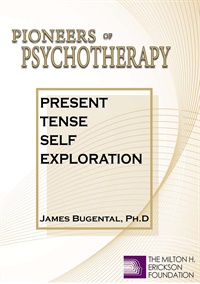
- Average Rating:
- Not yet rated
- Topic Areas:
- Clinical Demonstrations | Psychotherapy | Divorce | Marriage
- Bundle(s):
- Pioneers of Psychotherapy Bundle
- Categories:
- Pioneers of Psychotherapy | Evolution of Psychotherapy | Evolution of Psychotherapy 2000
- Faculty:
- James Bugental, PhD
- Course Levels:
- Master Degree or Higher in Health-Related Field
- Duration:
- 01:38:00
- Format:
- Audio and Video
- Original Program Date:
- May 27, 2000
- Short Description:
- James Bugental (2000) explains the importance of focusing on immediate subjective experiences. Bugental works with Glenda who is experiencing deep guilt about an upcoming divorce. Bugental addresses questions from the audience. A second volunteer explores issues surrounding her recent career change. Bugental explains his approach and answers questions.
- Price:
- $59.00 - Base Price
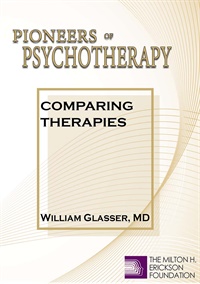
- Average Rating:
- Not yet rated
- Topic Areas:
- Clinical Demonstrations | Role Play | Psychotherapy
- Bundle(s):
- Pioneers of Psychotherapy Bundle
- Categories:
- Pioneers of Psychotherapy | Evolution of Psychotherapy | Evolution of Psychotherapy 2000
- Faculty:
- William Glasser, MD
- Course Levels:
- Master Degree or Higher in Health-Related Field
- Duration:
- 00:56:00
- Format:
- Audio and Video
- Original Program Date:
- May 27, 2000
- Short Description:
- William Glasser (2000) uses role-play with Marie who is simulating Paul, a male client from her place of employment. Paul has marriage problems. Marie, as Paul, is asked to role-play his wife. Glasser highlights choices, examines the client’s thinking, and focuses on responsible behavior. After the demonstration Glasser explains his work.
- Price:
- $59.00 - Base Price
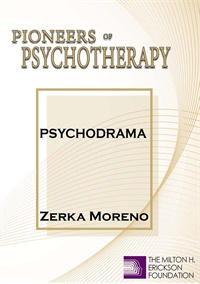
- Average Rating:
- Not yet rated
- Topic Areas:
- Clinical Demonstrations | Psychodrama | Psychotherapy | Role Play | Art and Creativity
- Bundle(s):
- Women Pioneers of Psychotherapy | Pioneers of Psychotherapy Bundle
- Categories:
- Pioneers of Psychotherapy | Evolution of Psychotherapy | Evolution of Psychotherapy 2000
- Faculty:
- Zerka Moreno
- Course Levels:
- Master Degree or Higher in Health-Related Field
- Duration:
- 01:01:00
- Format:
- Audio and Video
- Original Program Date:
- May 27, 2000
- Short Description:
- Zerka Moreno (2000) emphasizes the importance of spontaneity and creativity while demonstrating with Christi, who is asked to see her family photo and then construct it on stage using volunteers from the audience. These volunteers act as “auxiliary egos.” Following this demonstration Moreno plays all of the characters in a rolereversal she did with her 3 year-old son.
- Price:
-
Nate Sub 1.1 Price is $0.00
price reduced from Base Price - $59.00
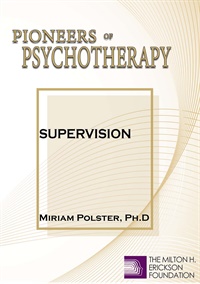
- Average Rating:
- Not yet rated
- Topic Areas:
- Clinical Demonstrations | Eating Disorders | Gestalt | Suicide | Psychotherapy | Supervision
- Bundle(s):
- Women Pioneers of Psychotherapy | Pioneers of Psychotherapy Bundle
- Categories:
- Pioneers of Psychotherapy | Evolution of Psychotherapy | Evolution of Psychotherapy 2000
- Faculty:
- Miriam Polster
- Course Levels:
- Master Degree or Higher in Health-Related Field
- Duration:
- 01:01:00
- Format:
- Audio and Video
- Original Program Date:
- May 26, 2000
- Short Description:
- Miriam Polster (2000) demonstrates supervision with Wendy, a clinical social worker who conducts therapy in the home. Polster’s supervision focuses on finding Wendy’s unique gifts and how these can be integrated into therapy. Next, Steve is working with a woman who has a history of bulimia and has threatened suicide. Polster follows this demonstration by explaining her work.
- Price:
-
Nate Sub 1.1 Price is $0.00
price reduced from Base Price - $59.00
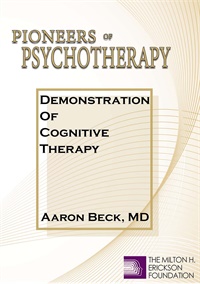
Credit available - Click Here for more information
- Average Rating:
- Not yet rated
- Topic Areas:
- Clinical Demonstrations | Abuse | Addiction | Psychotherapy | Role Play | Cognitive Behavior Therapy (CBT) | Relationships
- Bundle(s):
- Pioneers of Psychotherapy Bundle
- Categories:
- Pioneers of Psychotherapy | Online Continuing Education | Evolution of Psychotherapy | Evolution of Psychotherapy 1995
- Faculty:
- Aaron Beck, MD
- Course Levels:
- Master Degree or Higher in Health-Related Field
- Duration:
- 00:59:00
- Format:
- Audio and Video
- Original Program Date:
- Dec 15, 1995
- Short Description:
- Aaron Beck (1995) selects a clinician to role-play a male client. The client, Mike, was abandoned by his wife after she had multiple affairs. Mike is a recovering alcoholic with a sexually transmitted disease who suffers from dating anxiety, childhood trauma, and feelings of inferiority. Beck demonstrates how to establish a collaborative relationship with the patient.
- Price:
- $59.00 - Base Price
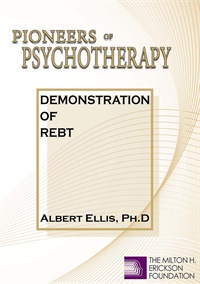
- Average Rating:
- Not yet rated
- Topic Areas:
- Clinical Demonstrations | Rational Emotive Behavior Therapy (REBT) | Homework | Humor
- Bundle(s):
- Pioneers of Psychotherapy Bundle
- Categories:
- Pioneers of Psychotherapy | Evolution of Psychotherapy | Evolution of Psychotherapy 1995
- Faculty:
- Albert Ellis, PhD
- Course Levels:
- Master Degree or Higher in Health-Related Field
- Duration:
- 01:01:00
- Format:
- Audio and Video
- Original Program Date:
- Dec 15, 1995
- Short Description:
- Ellis and Wolfe (1995) demonstrate with several volunteers. Beth, is troubled by her dominating mother. Ellis assigns a homework task. Next, Wolfe works with a volunteer who feels betrayed by her husband and brother. Ellis works with a second volunteer, Megan, who is ending a relationship with her boyfriend. Ellis uses imagery, confrontation and humor.
- Price:
- $59.00 - Base Price
Tags: Homework Humor REBT Albert Ellis
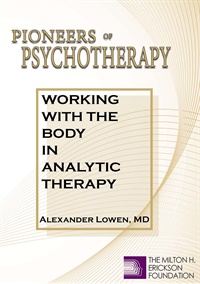
- Average Rating:
- Not yet rated
- Topic Areas:
- Clinical Demonstrations | Mind-Body | Psychotherapy | Bioenergetics
- Bundle(s):
- Pioneers of Psychotherapy Bundle
- Categories:
- Pioneers of Psychotherapy | Evolution of Psychotherapy | Evolution of Psychotherapy 1995
- Faculty:
- Alexander Lowen, MD
- Course Levels:
- Master Degree or Higher in Health-Related Field
- Duration:
- 01:01:00
- Format:
- Audio and Video
- Original Program Date:
- Dec 15, 1995
- Short Description:
- Alexander Lowen (1995) demonstrates with John who is dissatisfied with his body. Through exercises, Lowen helps John use his body to express his full range of feelings. Lowen explains that he does not rely on the mind to change behavior because of its lack of power. Lowen expects the body to free itself. The demonstration concludes with Lowen’s elaboration on his work.
- Price:
- $59.00 - Base Price
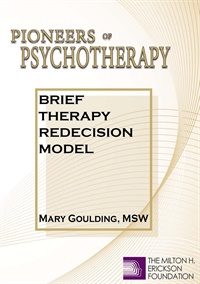
- Average Rating:
- Not yet rated
- Topic Areas:
- Clinical Demonstrations | Redecision Therapy | Brief Therapy | Psychotherapy | Relationships
- Bundle(s):
- Women Pioneers of Psychotherapy | Pioneers of Psychotherapy Bundle
- Categories:
- Pioneers of Psychotherapy | Evolution of Psychotherapy | Evolution of Psychotherapy 1995
- Faculty:
- Mary Goulding, MSW
- Course Levels:
- Master Degree or Higher in Health-Related Field
- Duration:
- 00:59:00
- Format:
- Audio and Video
- Original Program Date:
- Dec 15, 1995
- Short Description:
- Mary Goulding (1995) demonstrates with three volunteer clients. The first is disturbed because his mother did not spend much time with him during childhood. Next Dave is concerned about his distant relationship with his son. The third, Diane describes problems with her mother who is now a widow and overly critical. Goulding explains her work.
- Price:
- $59.00 - Base Price

- Average Rating:
- Not yet rated
- Topic Areas:
- Clinical Demonstrations | Reality Therapy | Psychotherapy | Abuse
- Bundle(s):
- Pioneers of Psychotherapy Bundle
- Categories:
- Pioneers of Psychotherapy | Evolution of Psychotherapy | Evolution of Psychotherapy 1995
- Faculty:
- William Glasser, MD
- Course Levels:
- Master Degree or Higher in Health-Related Field
- Duration:
- 00:59:00
- Format:
- Audio and Video
- Original Program Date:
- Dec 15, 1995
- Short Description:
- William Glasser (1995) demonstrates with a simulated client who is in an emotionally abusive relationship. This client is depressed and unhappy with her life. The goal of the first session is to focus on a behavioral change that can be accomplished as a first step. Glasser concludes with an explanation of the demonstration and of control theory.
- Price:
- $59.00 - Base Price

- Average Rating:
- Not yet rated
- Topic Areas:
- Clinical Demonstrations | Gestalt | Humor | Aging and Mortality | Psychotherapy
- Bundle(s):
- Pioneers of Psychotherapy Bundle
- Categories:
- Pioneers of Psychotherapy | Evolution of Psychotherapy | Evolution of Psychotherapy 1995
- Faculty:
- Erving Polster, PhD
- Course Levels:
- Master Degree or Higher in Health-Related Field
- Duration:
- 01:04:00
- Format:
- Audio and Video
- Original Program Date:
- Dec 14, 1995
- Short Description:
- Erving Polster (1995) demonstrates with Delisa, who is troubled by her work with geriatric patients. Polster leads Delisa quickly and deeply into her own fears of death and loss. Polster jokes, confronts, and directs Delisa into a greater self-awareness. Following the demonstration Polster explains his work and addresses questions.
- Price:
- $59.00 - Base Price
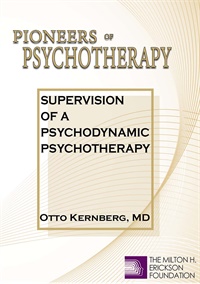
- Average Rating:
- Not yet rated
- Topic Areas:
- Clinical Demonstrations | Psychotherapy | Supervision
- Bundle(s):
- Pioneers of Psychotherapy Bundle
- Categories:
- Pioneers of Psychotherapy | Evolution of Psychotherapy | Evolution of Psychotherapy 1995
- Faculty:
- Otto Kernberg, MD
- Course Levels:
- Master Degree or Higher in Health-Related Field
- Duration:
- 01:06:00
- Format:
- Audio and Video
- Original Program Date:
- Dec 14, 1995
- Short Description:
- Otto Kernberg (1995) demonstrates a supervision session with a therapist who presents a case of a 42-year-old male with a narcissistic personality and self-destructive tendencies. This male therapist feels as though the therapy has reached a stalemate. Kernberg suggests various hypotheses about the case. The volunteer then describes his reaction to the supervision.
- Price:
- $59.00 - Base Price

- Average Rating:
- Not yet rated
- Topic Areas:
- Clinical Demonstrations | Ericksonian Hypnosis and Therapy Techniques | Ericksonian Psychotherapy | Utilization | Humor | Hypnosis | Psychotherapy
- Bundle(s):
- Pioneers of Psychotherapy Bundle
- Categories:
- Pioneers of Psychotherapy | Evolution of Psychotherapy | Evolution of Psychotherapy 1995
- Faculty:
- Jeffrey Zeig, PhD
- Course Levels:
- Master Degree or Higher in Health-Related Field
- Duration:
- 00:57:00
- Format:
- Audio and Video
- Original Program Date:
- Dec 14, 1995
- Short Description:
- Zeig (1995) demonstrates the Ericksonian approach to psychotherapy while working with Carol, a woman whose nail-biting habit is rooted in anxiety. After gathering information on her personal history, Zeig helps Carol utilize her values and history to affect change. The process is both humorous and dramatic. After working to change associations linked to the problem behavior, Zeig offers Carol an ordeal that will produce a "guaranteed cure." Hypnosis is offered as the "dessert", rather than the main course. Ericksonian approach to psychotherapy.
- Price:
- $59.00 - Base Price

- Average Rating:
- Not yet rated
- Topic Areas:
- Clinical Demonstrations | Mind-Body | Neuroscience | Psychotherapy | Hypnotic Phenomena
- Bundle(s):
- Pioneers of Psychotherapy Bundle
- Categories:
- Pioneers of Psychotherapy | Erickson Congress | Erickson Congress 1992
- Faculty:
- Ernest Rossi, PhD
- Course Levels:
- Master Degree or Higher in Health-Related Field
- Duration:
- 01:01:00
- Format:
- Audio and Video
- Original Program Date:
- Dec 02, 1992
- Short Description:
- Rossi (1992) demonstrates his approach to mind-body healing while working with a volunteer, Jennifer, who has rheumatoid arthristis in her hands, which have become distorted and painful. Rossi explains that mind-body healing follows a predictable pattern. During the final phase of this approach, Jennifer begins to experience automatic movement in her hands. She exclaims that her hands are moving more freely than they have in the last five years. Rossi attributes the success to "a genuine moment of self-empowerment."
- Price:
- $59.00 - Base Price

- Average Rating:
- Not yet rated
- Topic Areas:
- Clinical Demonstrations | Family Therapy | Psychotherapy
- Bundle(s):
- Pioneers of Psychotherapy Bundle
- Categories:
- Pioneers of Psychotherapy | Evolution of Psychotherapy | Evolution of Psychotherapy 1990 | Pioneers in Couples and Family Therapy
- Faculty:
- Carl Whitaker, MD
- Course Levels:
- Master Degree or Higher in Health-Related Field
- Duration:
- 00:59:00
- Format:
- Audio and Video
- Original Program Date:
- Dec 14, 1990
- Short Description:
- An innovative family systems intervention which demonstrates role flexibility, strategic reframing, and playful therapeutic techniques to address intergenerational anxiety and communication disruptions.
- Price:
- $59.00 - Base Price

